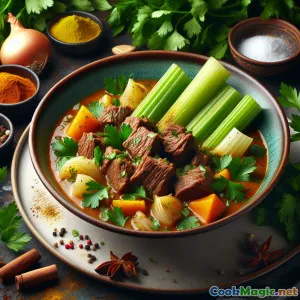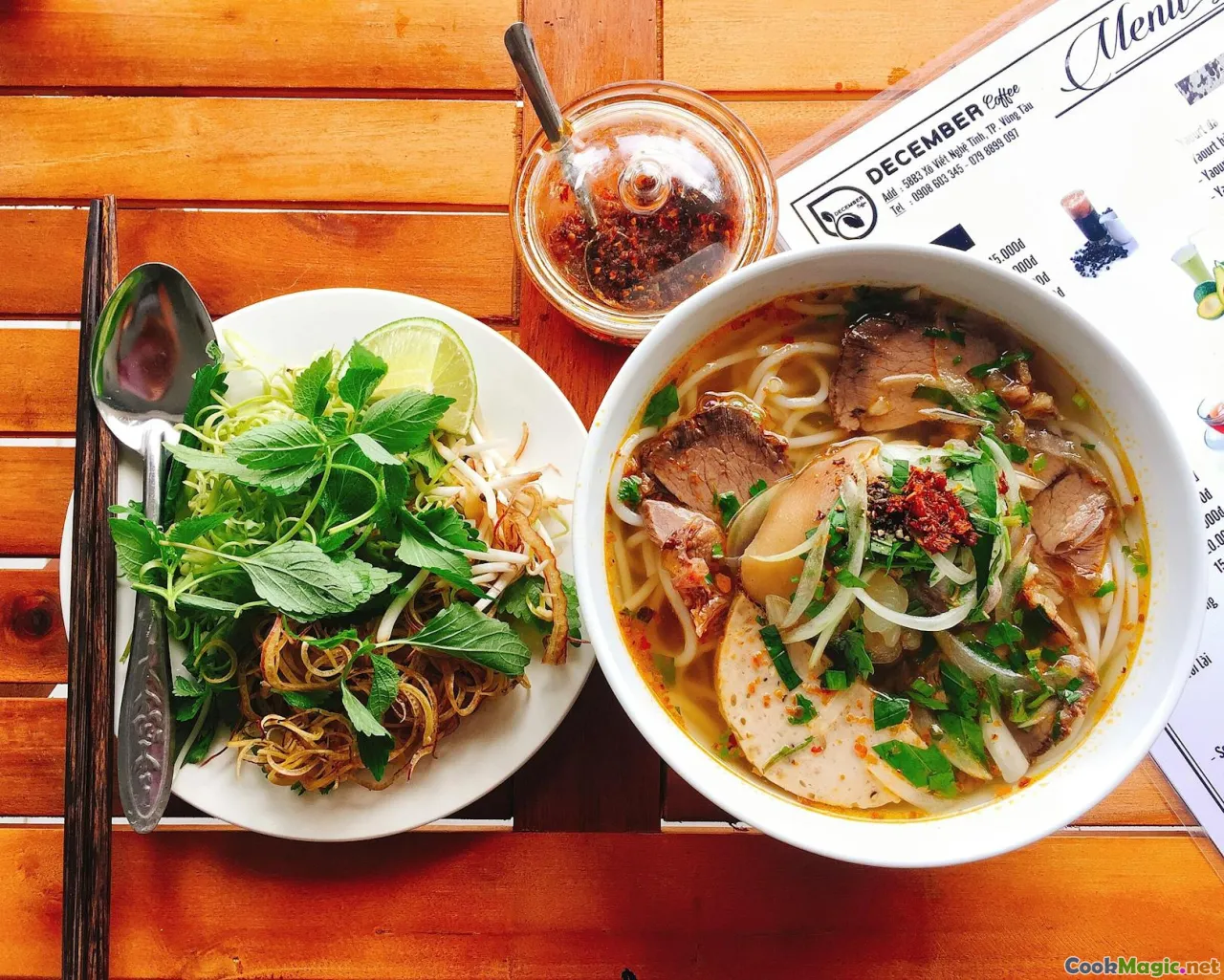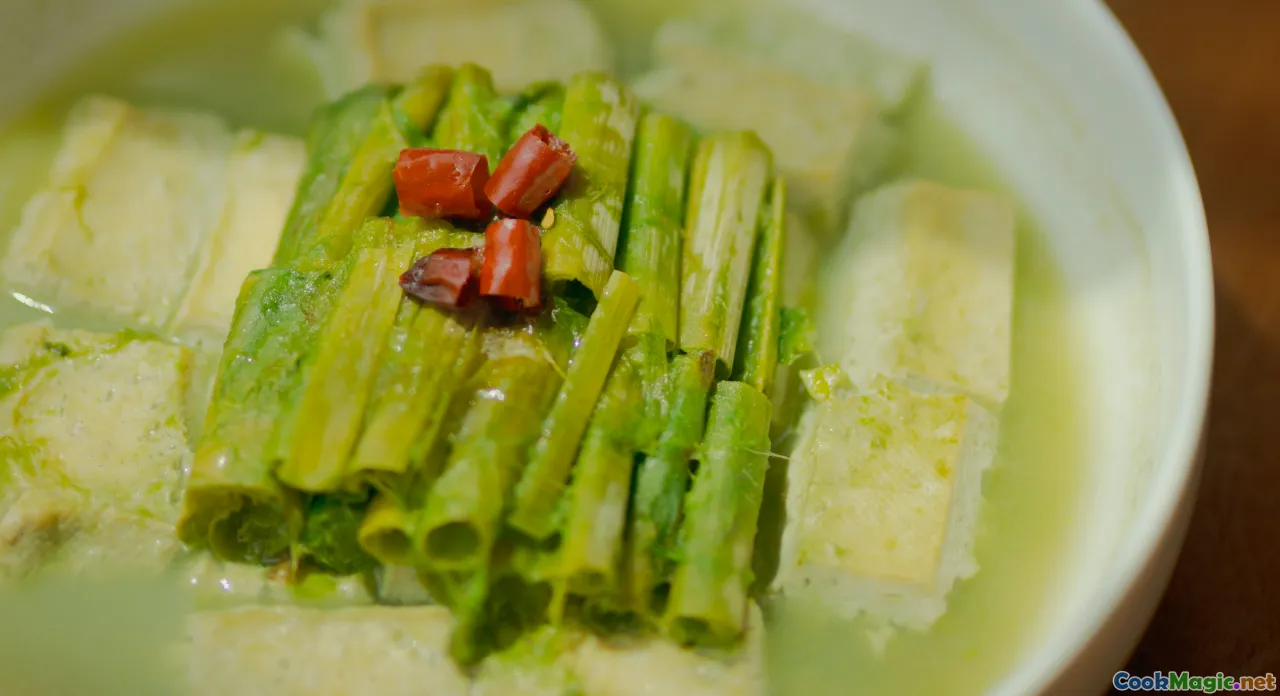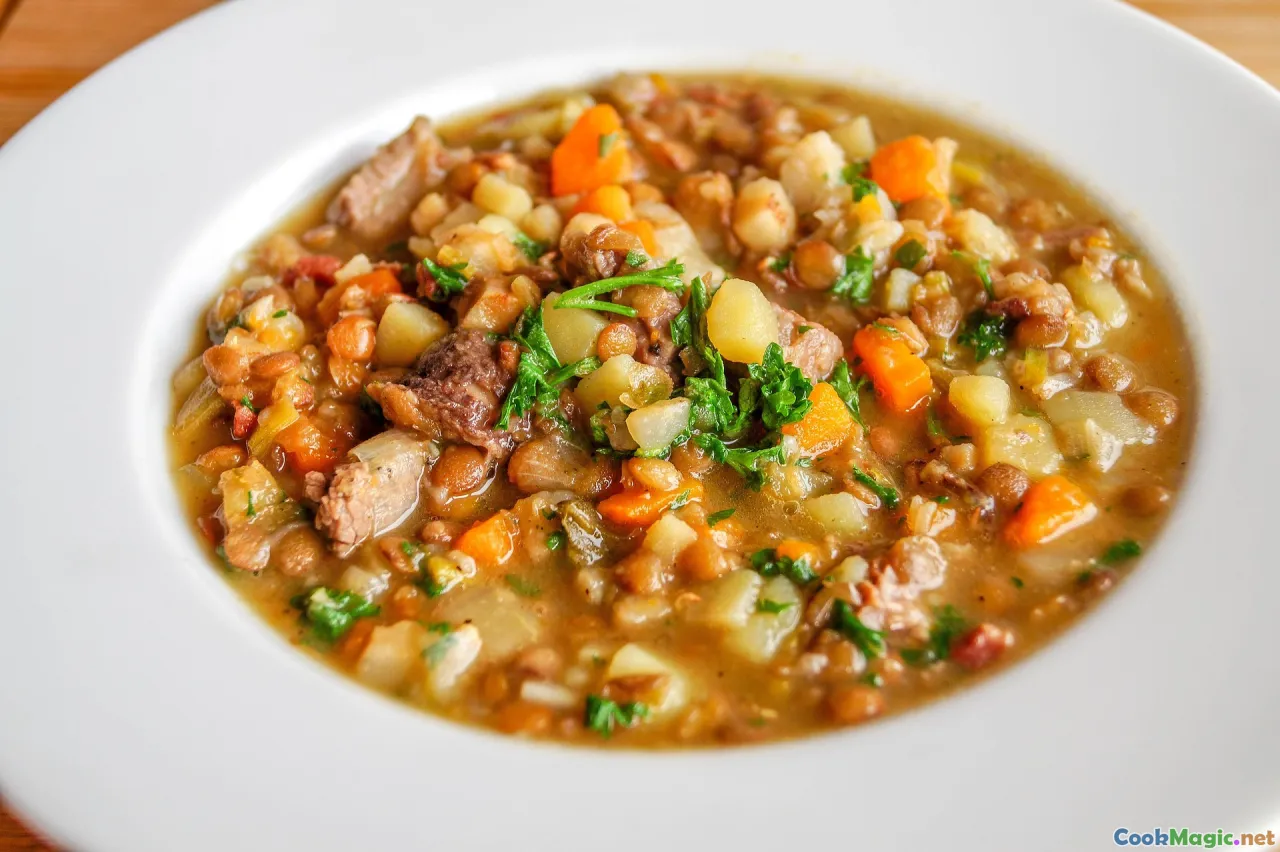
Perski gulasz z selera naciowego i wołowiny (Khoresh Karafs)
(Persian Celery and Beef Stew (Khoresh Karafs))
(0 Recenzje)0
387
październik 07, 2025
Zgłoś problem
Składniki
-
700 grams Łopatka wołowa, oczyszczona z tłuszczu i pokrojona w kostkę
(Cut into 3 cm cubes for even braising)
-
500 grams Łodygi selera
(Trim, peel fibrous strings, cut into 5 cm batons)
-
20 grams Liście selera naciowego
(Roughly chopped; adds fragrance and color)
-
60 grams Świeża pietruszka
(Finely chopped (about 2 packed cups))
-
2 tbsp Suszone mięta
(Lekko rozgnieść, aby uwolnić oleje)
-
1 large Cebula żółta
(Drobno posiekane)
-
4 cloves Ząbki czosnku
(Mielony)
-
1.5 tsp Proszek Kurkumy
(Classic khoresh foundation)
-
0.75 tsp Zmielony czarny pieprz
(Świeżo mielony dla najlepszego smaku)
-
1.5 tsp Sól kosher
(Dostosuj do smaku)
-
0.25 tsp Cynamon mielony
(Adds subtle warmth; use sparingly)
-
0.25 tsp Nici szafranu
(Bloom in 2 tbsp hot water)
-
3 whole Suszone limonki perskie (limoo amani)
(Pierce with a fork and soak 10 minutes)
-
1 tbsp Świeży Sok Cytrynowy
(For extra tang if limes are mild)
-
900 ml Bulion wołowy lub woda
(Enough to just cover the meat)
-
3 tbsp Olej neutralny
(Grapeseed or canola)
-
15 grams Świeże Liście Mięty
(Chopped; finish for brightness)
(Cut into 3 cm cubes for even braising)
(Trim, peel fibrous strings, cut into 5 cm batons)
(Roughly chopped; adds fragrance and color)
(Finely chopped (about 2 packed cups))
(Lekko rozgnieść, aby uwolnić oleje)
(Drobno posiekane)
(Mielony)
(Classic khoresh foundation)
(Świeżo mielony dla najlepszego smaku)
(Dostosuj do smaku)
(Adds subtle warmth; use sparingly)
(Bloom in 2 tbsp hot water)
(Pierce with a fork and soak 10 minutes)
(For extra tang if limes are mild)
(Enough to just cover the meat)
(Grapeseed or canola)
(Chopped; finish for brightness)
Wartości odżywcze
- Porcje: 6
- Wielkość porcji: 1 miska (350g)
- Calories: 380 kcal
- Carbohydrates: 0 g
- Protein: 29 g
- Fat: 23 g
- Fiber: 3 g
- Sugar: 4 g
- Sodium: 780 mg
- Cholesterol: 85 mg
- Calcium: 80 mg
- Iron: 4.5 mg
Instrukcje
-
1 - Prep the aromatics and herbs:
Dice the onion, mince the garlic, finely chop parsley and celery leaves. Lightly crush dried mint between your palms. Pierce dried limes several times and soak in warm water.
-
2 - Brown the Beef:
Heat 2 tbsp oil in a heavy pot over medium-high. Pat beef dry and sear in two batches until well browned on at least two sides. Transfer to a plate.
-
3 - Soften onions and toast spices:
Add remaining 1 tbsp oil and the onion. Cook until translucent. Stir in garlic, turmeric, black pepper, and cinnamon; toast until fragrant.
-
4 - Deglaze the pot:
Pour in a splash of stock, scraping up browned bits to build flavor.
-
5 - Build the Stew Base:
Return beef and accumulated juices. Add salt and enough stock to just cover. Bring to a gentle simmer.
-
6 - Slow simmer the beef:
Cover and simmer on low until the beef begins to turn tender, skimming any foam. Adjust heat to maintain a quiet bubble.
-
7 - Prep and perfume the celery:
Strip any tough strings from celery with a peeler, cut into batons. Warm dried mint in a dry pan for 30 seconds to heighten aroma.
-
8 - Sauté the celery:
In a skillet, lightly sauté celery in a bit of oil from the pot (or 1 tsp fresh oil) until glossy and bright green; avoid deep browning.
-
9 - Add herbs and limes:
Stir parsley, celery leaves, warmed dried mint, and sautéed celery into the stew. Nestle in the soaked, pierced dried limes.
-
10 - Final gentle simmer:
Simmer uncovered until the celery is tender but intact and the broth is glossy and slightly reduced. Avoid vigorous boiling to prevent bitterness from the limes.
-
11 - Finish and balance:
Stir in bloomed saffron and lemon juice if desired. Taste and adjust salt and pepper. Remove or leave limes for serving, as preferred.
-
12 - Rest and Serve:
Let stew rest off heat for a couple of minutes. Serve hot with saffron basmati rice, torshi (pickles), and fresh herbs.
Dice the onion, mince the garlic, finely chop parsley and celery leaves. Lightly crush dried mint between your palms. Pierce dried limes several times and soak in warm water.
Heat 2 tbsp oil in a heavy pot over medium-high. Pat beef dry and sear in two batches until well browned on at least two sides. Transfer to a plate.
Add remaining 1 tbsp oil and the onion. Cook until translucent. Stir in garlic, turmeric, black pepper, and cinnamon; toast until fragrant.
Pour in a splash of stock, scraping up browned bits to build flavor.
Return beef and accumulated juices. Add salt and enough stock to just cover. Bring to a gentle simmer.
Cover and simmer on low until the beef begins to turn tender, skimming any foam. Adjust heat to maintain a quiet bubble.
Strip any tough strings from celery with a peeler, cut into batons. Warm dried mint in a dry pan for 30 seconds to heighten aroma.
In a skillet, lightly sauté celery in a bit of oil from the pot (or 1 tsp fresh oil) until glossy and bright green; avoid deep browning.
Stir parsley, celery leaves, warmed dried mint, and sautéed celery into the stew. Nestle in the soaked, pierced dried limes.
Simmer uncovered until the celery is tender but intact and the broth is glossy and slightly reduced. Avoid vigorous boiling to prevent bitterness from the limes.
Stir in bloomed saffron and lemon juice if desired. Taste and adjust salt and pepper. Remove or leave limes for serving, as preferred.
Let stew rest off heat for a couple of minutes. Serve hot with saffron basmati rice, torshi (pickles), and fresh herbs.
Więcej o: Perski gulasz z selera naciowego i wołowiny (Khoresh Karafs)
The Story and Soul of Khoresh Karafs
Persian Celery and Beef Stew—known in Persian as khoresh karafs—is a celebration of herbs, celery, and patience. It is often overshadowed internationally by its tomato-rich cousins, yet it holds a special, herbaceous charm that defines the green heart of Persian home cooking. At its core, this stew transforms humble celery into a leading character, bolstered by tender beef, a chorus of parsley and mint, and the tangy, perfumed nudge of dried Persian limes. When prepared with care, the broth becomes luminous and savory, with a green-gold hue that invites you to ladle it generously over fluffy saffron basmati rice.
What Makes This Version Unique
- Herb-forward balance: Many versions lean heavily on celery alone; this recipe embraces a robust blend of parsley, celery leaves, and dried mint for layers of aroma. The brief toasting of dried mint intensifies its fragrance without turning it bitter.
- Thoughtful celery technique: Peeling the fibrous strings and sautéing lightly protects the vegetable’s structure, keeping the batons vibrant and tender instead of limp.
- Gentle lime management: Soaking and piercing the dried limes coaxes out their citrusy, black-lime perfume while preventing harsh bitterness. Simmering rather than boiling preserves their nuanced tang.
- Saffron finish: Bloomed saffron stirred in at the end gives the stew a warm, honeyed depth and a glowing finish that feels distinctly Persian.
Serving Suggestions
- Rice companion: Steamed saffron basmati rice (chelo) is the classic pairing. The grains catch the stew’s glossy juices without turning stodgy.
- Sides and textures: Offer crunchy torshi (pickles), crisp radishes, and a platter of fresh herbs—mint, parsley, tarragon—for a bright counterpoint.
- For gatherings: Serve family-style in a wide, shallow dish so the green colors and glistening celery are on full display.
Tips and Notes
- Beef choice: Beef chuck is ideal for slow simmering; its marbling melts into silkiness. Shoulder works well, too. Cut into even cubes for consistent tenderness.
- Control the heat: A soft simmer is key. Boiling can toughen the beef and over-extract bitterness from dried limes.
- Salt timing: Start modestly and finish assertively. As flavors condense, salinity concentrates; adjust just before serving.
- Herb handling: Chop parsley finely but not to a paste, so it ribbons through the broth and stays bright. If using fresh mint, add it at the very end to preserve freshness.
- Make-ahead magic: This stew tastes even better on day two, as the citrusy-lime and herb notes meld. Reheat gently, adding a splash of water if the sauce thickens too much.
- Celery alternatives: In a pinch, add a handful of chopped leek greens or a little spinach with the herbs for body—though celery remains the star.
Cultural Significance
In Iran, khoresh is more than a stew; it is a format that expresses place, season, and family. Khoresh karafs is often served at casual family meals and weekend gatherings. It straddles comfort and freshness: a slow-cooked base with quick, aromatic finishes. The dried lime—limoo amani—is a distinct hallmark of Persian cuisine, bringing a haunting citrus note that tastes like sun-concentrated lime and smoky tea. Its aromatic signature telegraphs home to many Iranians, evoking memories of shared tables and rice perfumed with saffron.
Technique Walkthrough
- Build the fond: Searing the beef develops browned bits that later dissolve into the sauce, creating depth without heavy spices.
- Toast judiciously: Briefly blooming turmeric and cinnamon in oil unlocks flavor; over-toasting can turn them acrid.
- Manage greens: Stirring in herbs later in the cook protects their color and aroma. Dried mint, warmed separately, behaves like a seasoning rather than a leafy herb.
- Lime logic: Piercing dried limes lets their juices mingle with the stew. If you prefer a softer citrus presence, keep them whole and remove before serving; for bolder tang, squeeze them gently at the end.
Variations
- Lamb twist: Substitute lamb shoulder for beef; reduce the initial simmer by 10–15 minutes, as lamb often tenderizes more quickly.
- Vegetarian pathway: Swap beef for hearty mushrooms (cremini and oyster) and chickpeas. Build fond with mushrooms, then proceed, adjusting stock and salt.
- Extra-green finish: Stir in a handful of chopped fresh mint at the end for a springlike lift.
Troubleshooting
- Too bitter: Remove the dried limes, add a splash of water, and balance with a pinch of sugar or a few drops of lemon juice. Keep the simmer low next time.
- Celery too soft: Sauté less aggressively and add it later. Firm celery is a signature texture here.
- Pale flavor: Extend the uncovered simmer by a few minutes to concentrate; finish with saffron and a final salt adjustment.
Final Thoughts
Khoresh karafs rewards attentiveness more than complexity. With a few ingredients—celery, herbs, beef, and dried limes—you build a stew that tastes much bigger than the sum of its parts. Its green perfume, gentle tang, and tender beef make it equally suited to a celebratory spread or a quiet evening at home. Take your time, mind the simmer, and let the kitchen fill with the herb-lime steam that has comforted Persian households for generations.






















